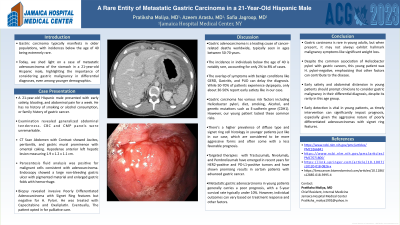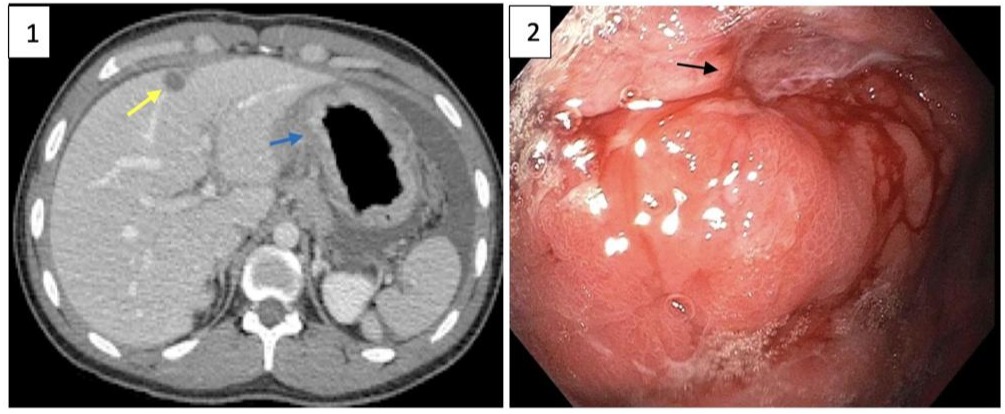Tuesday Poster Session
Category: Stomach
P4189 - A Rare Entity of Metastatic Gastric Carcinoma in a 21-Year-Old Hispanic Male
Tuesday, October 24, 2023
10:30 AM - 4:00 PM PT
Location: Exhibit Hall

Has Audio

Pratiksha Moliya, MD
Jamaica Hospital Medical Center
Edison, NJ
Presenting Author(s)
Pratiksha Moliya, MD1, Azeem Arastu, MD2, Sofia Jagroop, MD2
1Jamaica Hospital Medical Center, Edison, NJ; 2Jamaica Hospital Medical Center, New York, NY
Introduction: Gastric cancer is the fifth most common and 3rd most deadly neoplasm globally. Gastric carcinoma occurs most often in the age group of 50–70 years, and it is infrequent below the age of 40, with an estimate of 2% to 8%. We are presenting a compelling case of metastatic adenocarcinoma of the stomach in a 21-year-old Hispanic male.
Case Description/Methods: A 21-year-old Hispanic male with no significant history of smoking, alcohol consumption, or family history of gastric cancer presented with complaints of abdominal pain, early satiety, bloating, non-bloody,non-bilious emesis, and 3-4 daily episodes of non-bloody diarrhea. The CT abdomen and pelvis with contrast revealed abdominal/pelvic ascites and a hypodense anterior hepatic lesion. Diagnostic Paracentesis was significant for adenocarcinomatous malignant cells. EGD with biopsy from gastric ulcer was positive for gastric adenocarcinoma. Chemotherapy was initiated as per Oncology recommendations. Eventually, the goals of care were discussed. The patient has opted in for palliative care.
Discussion: Gastric carcinoma's etiology is multifactorial, including Helicobacter pylori infection, dietary factors, smoking, and genetic predisposition. Diagnosis is often delayed due to nonspecific symptoms, such as dyspepsia or anemia, Though presenting symptoms were not alarming, like significant weight loss, In light of Existing early satiety, progressively distended abdomen, and generalized tenderness on physical examination, a CT abdomen, Ascitic tapping and EGD with gastric biopsy were performed, which evidenced a non-obstructing non-bleeding gastric ulcer with pigmented material and enlarged gastric folds with hemorrhage. Pathology results suggested poorly differentiated adenocarcinoma with signet ring features. Although H Pylori is a crucial risk factor, H pylori stain was negative. Treatment involves surgical resection for localized disease and chemotherapy for advanced stages. Targeted therapies have emerged in recent years for HER2-positive and PD-L1-positive tumors. With the lack of cardinal gastric malignancy symptoms like weight loss, young patients may mislead the physicians in the diagnostic process. Therefore, though rare, Clinicians should keep gastric malignancy in the differential list in young patients presenting symptoms of early satiety and abdominal distension, as the early diagnosis of a gastric tumor in this group plays a crucial role in determining the prognosis.

Disclosures:
Pratiksha Moliya, MD1, Azeem Arastu, MD2, Sofia Jagroop, MD2. P4189 - A Rare Entity of Metastatic Gastric Carcinoma in a 21-Year-Old Hispanic Male, ACG 2023 Annual Scientific Meeting Abstracts. Vancouver, BC, Canada: American College of Gastroenterology.
1Jamaica Hospital Medical Center, Edison, NJ; 2Jamaica Hospital Medical Center, New York, NY
Introduction: Gastric cancer is the fifth most common and 3rd most deadly neoplasm globally. Gastric carcinoma occurs most often in the age group of 50–70 years, and it is infrequent below the age of 40, with an estimate of 2% to 8%. We are presenting a compelling case of metastatic adenocarcinoma of the stomach in a 21-year-old Hispanic male.
Case Description/Methods: A 21-year-old Hispanic male with no significant history of smoking, alcohol consumption, or family history of gastric cancer presented with complaints of abdominal pain, early satiety, bloating, non-bloody,non-bilious emesis, and 3-4 daily episodes of non-bloody diarrhea. The CT abdomen and pelvis with contrast revealed abdominal/pelvic ascites and a hypodense anterior hepatic lesion. Diagnostic Paracentesis was significant for adenocarcinomatous malignant cells. EGD with biopsy from gastric ulcer was positive for gastric adenocarcinoma. Chemotherapy was initiated as per Oncology recommendations. Eventually, the goals of care were discussed. The patient has opted in for palliative care.
Discussion: Gastric carcinoma's etiology is multifactorial, including Helicobacter pylori infection, dietary factors, smoking, and genetic predisposition. Diagnosis is often delayed due to nonspecific symptoms, such as dyspepsia or anemia, Though presenting symptoms were not alarming, like significant weight loss, In light of Existing early satiety, progressively distended abdomen, and generalized tenderness on physical examination, a CT abdomen, Ascitic tapping and EGD with gastric biopsy were performed, which evidenced a non-obstructing non-bleeding gastric ulcer with pigmented material and enlarged gastric folds with hemorrhage. Pathology results suggested poorly differentiated adenocarcinoma with signet ring features. Although H Pylori is a crucial risk factor, H pylori stain was negative. Treatment involves surgical resection for localized disease and chemotherapy for advanced stages. Targeted therapies have emerged in recent years for HER2-positive and PD-L1-positive tumors. With the lack of cardinal gastric malignancy symptoms like weight loss, young patients may mislead the physicians in the diagnostic process. Therefore, though rare, Clinicians should keep gastric malignancy in the differential list in young patients presenting symptoms of early satiety and abdominal distension, as the early diagnosis of a gastric tumor in this group plays a crucial role in determining the prognosis.

Figure: CT and Endoscopy image
Disclosures:
Pratiksha Moliya indicated no relevant financial relationships.
Azeem Arastu indicated no relevant financial relationships.
Sofia Jagroop indicated no relevant financial relationships.
Pratiksha Moliya, MD1, Azeem Arastu, MD2, Sofia Jagroop, MD2. P4189 - A Rare Entity of Metastatic Gastric Carcinoma in a 21-Year-Old Hispanic Male, ACG 2023 Annual Scientific Meeting Abstracts. Vancouver, BC, Canada: American College of Gastroenterology.
